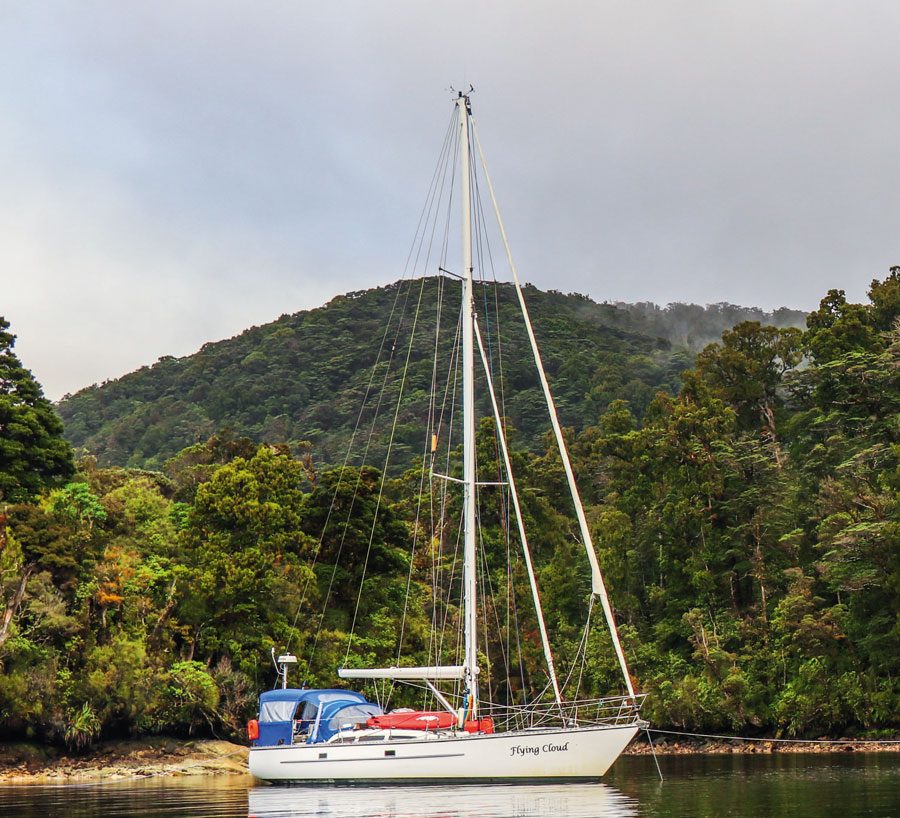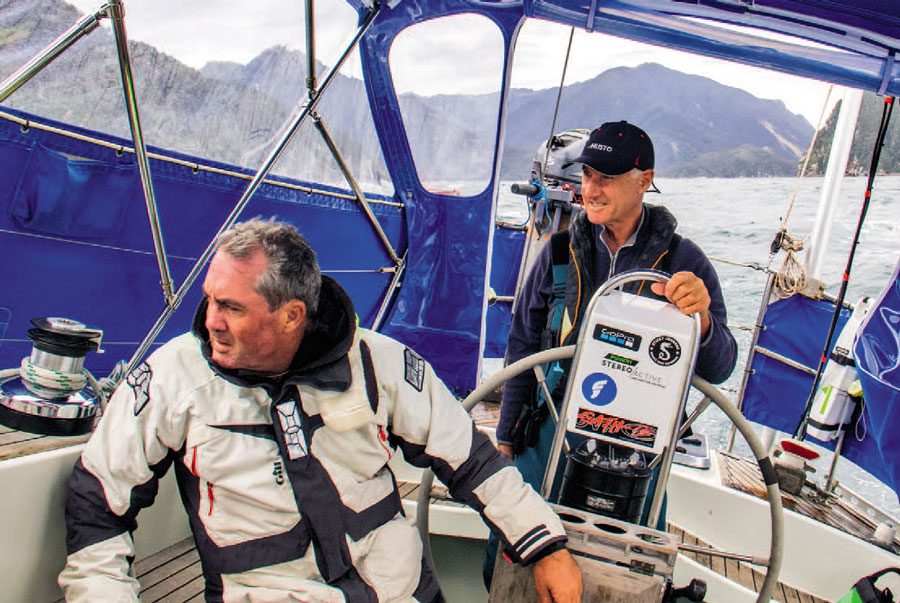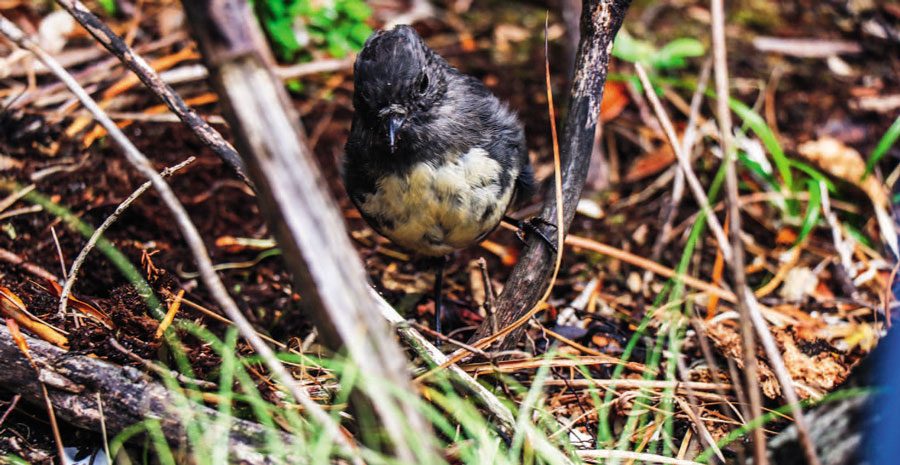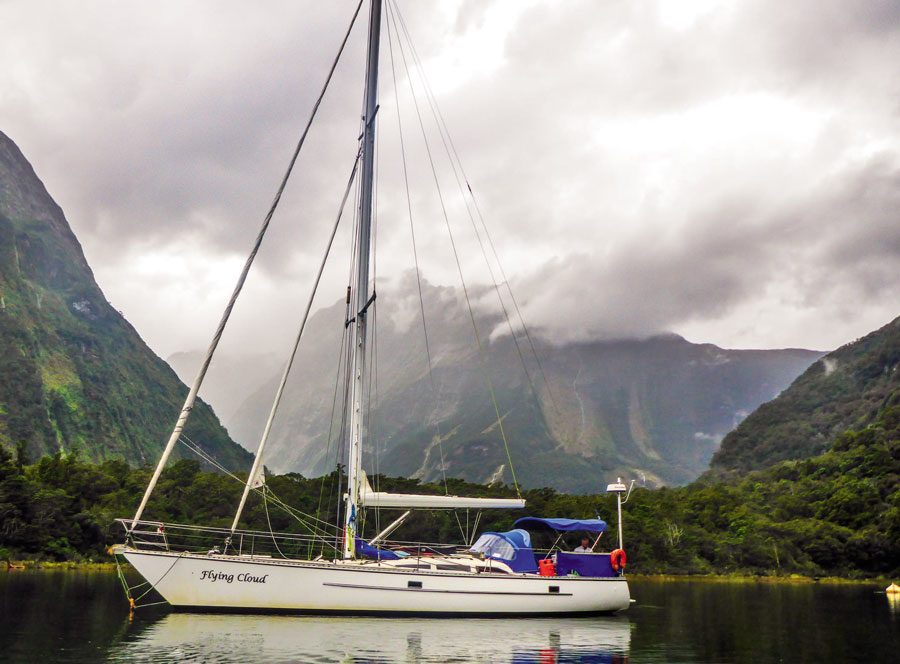

The adventure continues for the crew of the Auckland yacht Flying Cloud as they take time to explore Fiordland before heading north for home.
Martin, Adam and Johnny joined me for the leg from Stewart Island to Fiordland. We had heard stories of yachts waiting many weeks for an opening in the weather to cross Foveaux Strait and round the notorious Puysegur Point in to Preservation Inlet, so when a weather window opened sooner than expected, the guys wasted no time getting to Oban and prepping for Fiordland.
The advice we’d been given was to head to Port William on the northeast coast of Stewart Island and use it as a jumping off point for the overnight passage. At 80 nautical miles and with the long summer days, the passage could be achieved during daylight hours, but if conditions deteriorated or if the currents were stronger than predicted, we did not want to risk rounding Puysegur at dusk and finding our way into Preservation Inlet in the dark.
 In Cormorant Cove, Dusky Sound, with our friends aboard Otama.
In Cormorant Cove, Dusky Sound, with our friends aboard Otama.
The night sail was cold and lumpy, but for this part of the world, certainly not what you’d call rough. We approached Puysegur with 15 knots on the beam and the dawn light illuminating the cliffs of Chalky Island in the distance. We closed in on our friends on board Otama who had left Stewart Island a couple of hours before us and we enjoyed the moment sailing into Fiordland together.
The new crew were all action men! Adam and Martin had joined us at different times sailing in Fiji and French Polynesia. They knew Flying Cloud well and the fun she inevitably leads us to. The day was spectacular! Bluebird skies and light winds.
We took the opportunity to anchor inside the Spit Islands on the northern side of the inlet. The shore party enjoyed a stroll along the beach gathering pipis and up through the sand dunes bordering the dense bush behind. It felt more like Northland than the Fiordland we were expecting.
 Swinging at anchor, Crooked Arm, Doubtful Sound.
Swinging at anchor, Crooked Arm, Doubtful Sound.
In the afternoon, Adam and Johnny suited up and dived for scallops but instead found crayfish the size of which they had never seen before! (And that’s saying something for Adam who has spent countless hours exploring underwater to the limits of his breath hold.) Securely anchored in Cuttle Cove for the night, we dined well with blue cod and paua complementing the crayfish.
Our time in Fiordland was punctuated by highlights. The sail up Long Sound in Preservation Inlet to the idyllic anchorage in Cascade Basin; negotiating the torrents of water from the waterfall there on the paddle board; anchoring in calm conditions in Otago’s Retreat and hiking out to the Puysegur Lighthouse.
In Chalky Inlet we surfed a boulder bank and could only wonder at how it would go with a big Southern Ocean swell rolling in, enjoyed the serenity of the perfect anchorage of North Harbour, explored Edwardson Sound, and awaited Sue, TL and Harriet’s arrival on the chopper on yet another bluebird day.
Dusky Sound is steeped in history and is the epicentre of conservation efforts. Anchored in Shark Cove at the very top of the sound in heavy overnight rain, we awoke to be surrounded by waterfalls and the smell of the freshness of the bush washed down onto the water. A glorious sail followed with a southerly breeze up Acheron Passage to Breaksea Sound and the spectacular heights and immense scale of the Broughton Arm.
 Sailing with the the cockpit enclosed – it might be summer but it is Fiordland!
Sailing with the the cockpit enclosed – it might be summer but it is Fiordland!
 Dawn off Karamea on the way back north.
Dawn off Karamea on the way back north.
Then a fair weather passage up to Doubtful Sound and our first taste of civilisation in weeks. Engulfed in the magnitude of the Hall Arm, we partied with friends Derek and Melissa on a breathless night under the stars to the tunes that have shaped us. Up the Camelot River by dinghy and on further by foot along the banks overlooking rock pools of crystal-clear water flowing swiftly around massive granite boulders, one of which must surely have been where the name ‘Camelot’ came from.
During a nor’west gale we spent three days sheltered in the calm of Precipice Cove in Bradshaw Sound. With two sternlines ashore, we appreciated the advice of fishermen who had touted this as the best anchorage in Fiordland.
In late February Phil and Chris joined me in Doubtful Sound, arriving on the same bus that Sue went out on. That afternoon we had one of the roughest passages of the trip – just a short hop from Thompson Sound to Charles Sound, but the north wind was against a southerly current and the seas were short and steep.
We took green water over the bow and it came as a timely reminder to reconfigure Flying Cloud into offshore mode for the open ocean passages to come. This primarily involves moving weight out of the bow area and re-stowing it aft and amidships. Many cruisers don’t bother to optimise their boats, but a few kilograms of ropes and sails removed from the bow can transform it, making it significantly more sea-kindly and ultimately safer.
 Marjorie Falls, Irene River, Charles Sound
Marjorie Falls, Irene River, Charles Sound
About a mile inside Charles Sound we were surrounded by a school of albacore tuna jumping – a surreal sight when surrounded by mountains and a spectacle we’d only ever seen on the open ocean.
Further north in George Sound we found Otama anchored at Alice Falls and gave them some of the fresh albacore and swapped notes on the approaching weather windows for the passage up the west coast. It looked like the wind would go from northerly to westerly in three days’ time and we wanted to be up in Milford Sound ahead of the game.
The approach into Milford Sound felt special. Maybe it was the because Milford is the icon of Fiordland and to have sailed there felt like an achievement. Without doubt, it has the steepest most vertical sides and the highest peaks of all the fiords. The grandeur of it is something to behold! The local pod of bottlenose dolphins escorted us all the way up to Freshwater Basin where the skipper of one of the tour boats gave us his mooring for the time we were there.
 Melissa and Derek on the Crooked Arm of Doubtful Sound
Melissa and Derek on the Crooked Arm of Doubtful Sound
After a couple of days there the wind was due to shift from north to west early the following afternoon. We planned to head out early in the morning in case the conditions outside the sound weren’t too bad and we could effectively sail to windward for six or so hours to get a head start. We had torrential rain all night and in the morning the wind was squally and the visibility poor. Not what we’d hoped for, but we set off anyway and were treated to seeing Milford Sound in all its splendour.
The rain cleared as we motored out and our ears were assaulted by a wall of sound from water falling everywhere from great heights, shaped by the wind as it poured down on the sea’s surface below. Fiordland had blown us away yet again!
Outside, the conditions were comfortable with winds in the 15 to 20 knots range and we tacked towards the north using the wind shifts that came our way. Forty miles up the coast we were lifting on port tack and came in close enough to get a good view of Cascade Point. We had never heard of it but we’d stumbled on to what was one of the most spectacular sights of the trip: three streams flowing over the edge of 60m-high cliffs and falling top to bottom onto the breakers and rocks below.
 Tomtit
Tomtit
The wind soon backed to the west and we had a fast trip with eased sheets for the next two days, up the coast and around Farewell Spit into Tasman Bay.
A few weeks later, with the benefit of being able to wait for ideal conditions, we had a fast two-and-a-half day sail up the west coast of the North Island, rounding Cape Reinga and anchoring off Spirits Bay on a calm night where we caught snapper for dinner – a change from blue cod, the onboard delicacy of the previous months.
Four day-sails down the coast of Northland later, approaching home from the opposite direction to which we had set out, the satisfaction of having completed a circumnavigation began to sink in. In the months since, it sometimes seems hard to believe that everything that happened to us sailing around New Zealand was real. BNZ
 Flying Cloud anchored in Deepwater Basin, Milford Sound.
Flying Cloud anchored in Deepwater Basin, Milford Sound.
WEATHER FORECASTING
I use Predictwind to see what the major weather models are saying for the days ahead and to estimate what our progress will be like using the departure planning and routing functions. But when it’s not straightforward, I don’t hesitate to call friends with experience and I often ask for help from meteorologist Roger Badham. His interpretation of what the models are saying, how accurate they are likely to be, the amount of wind in the system and the sea state is like a reality check. Someone looking in from afar can bring an added and more considered perspective.
We found that the ECMWF model available on PredictWind tended to give the most accurate forecast in close proximity to the coast. This gave us the confidence to put to sea when other models and the maritime weather bulletin said that we should not. Maritime weather bulletins cannot cover localised variations within the sea area.
On two occasions, ECMWF showed a light wind zone lasting from dawn until midday within five miles of the Fiordland coast in an otherwise strong nor-easterly flow. We sailed from Charles Sound to George Sound and later, from George Sound to Milford Sound on these narrow weather windows.
There is no cell reception through most of Stewart Island and Fiordland, so we relied on our Iridium Go satellite phone and the interface that the PredictWind software provides to be able to receive daily weather updates. This function also reports our position every hour on our page on the PredictWind website. We were lucky to have a good friend following our progress when we were at sea thus adding a comforting and valuable measure of safety to our trip.




